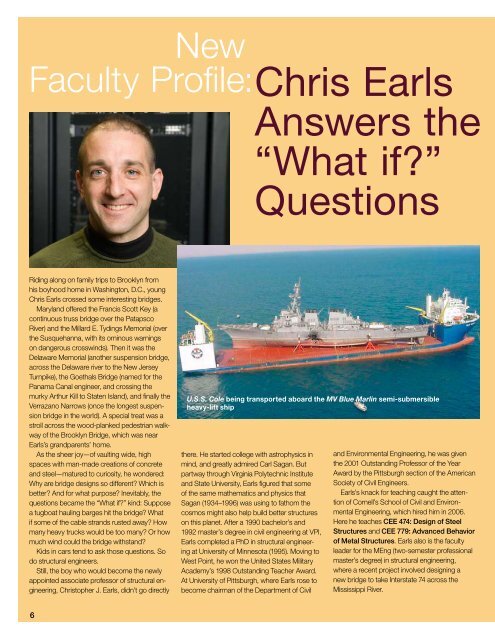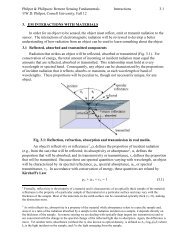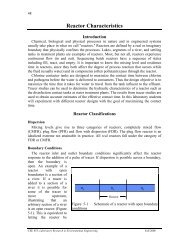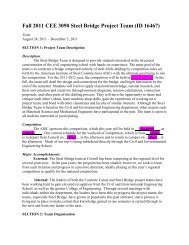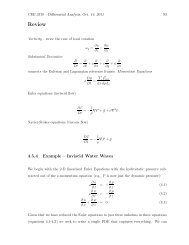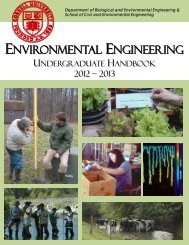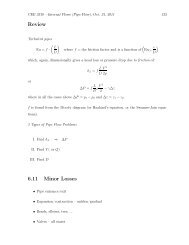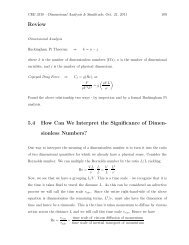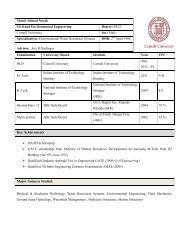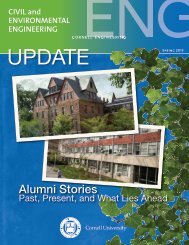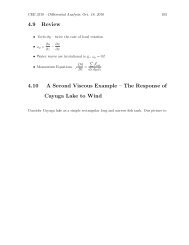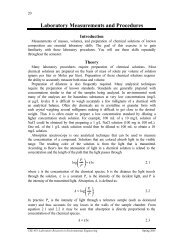Spring 2007 - Civil & Environmental Engineering - Cornell University
Spring 2007 - Civil & Environmental Engineering - Cornell University
Spring 2007 - Civil & Environmental Engineering - Cornell University
Create successful ePaper yourself
Turn your PDF publications into a flip-book with our unique Google optimized e-Paper software.
New<br />
Faculty Profile:Chris Earls<br />
Answers the<br />
“What if?”<br />
Questions<br />
Riding along on family trips to Brooklyn from<br />
his boyhood home in Washington, D.C., young<br />
Chris Earls crossed some interesting bridges.<br />
Maryland offered the Francis Scott Key (a<br />
continuous truss bridge over the Patapsco<br />
River) and the Millard E. Tydings Memorial (over<br />
the Susquehanna, with its ominous warnings<br />
on dangerous crosswinds). Then it was the<br />
Delaware Memorial (another suspension bridge,<br />
across the Delaware river to the New Jersey<br />
Turnpike), the Goethals Bridge (named for the<br />
Panama Canal engineer, and crossing the<br />
murky Arthur Kill to Staten Island), and finally the<br />
Verrazano Narrows (once the longest suspension<br />
bridge in the world). A special treat was a<br />
stroll across the wood-planked pedestrian walkway<br />
of the Brooklyn Bridge, which was near<br />
Earls’s grandparents’ home.<br />
As the sheer joy—of vaulting wide, high<br />
spaces with man-made creations of concrete<br />
and steel—matured to curiosity, he wondered:<br />
Why are bridge designs so different? Which is<br />
better? And for what purpose? Inevitably, the<br />
questions became the “What if?” kind: Suppose<br />
a tugboat hauling barges hit the bridge? What<br />
if some of the cable strands rusted away? How<br />
many heavy trucks would be too many? Or how<br />
much wind could the bridge withstand?<br />
Kids in cars tend to ask those questions. So<br />
do structural engineers.<br />
Still, the boy who would become the newly<br />
appointed associate professor of structural engineering,<br />
Christopher J. Earls, didn’t go directly<br />
U.S.S. Cole being transported aboard the MV Blue Marlin semi-submersible<br />
heavy-lift ship<br />
there. He started college with astrophysics in<br />
mind, and greatly admired Carl Sagan. But<br />
partway through Virginia Polytechnic Institute<br />
and State <strong>University</strong>, Earls figured that some<br />
of the same mathematics and physics that<br />
Sagan (1934–1996) was using to fathom the<br />
cosmos might also help build better structures<br />
on this planet. After a 1990 bachelor’s and<br />
1992 master’s degree in civil engineering at VPI,<br />
Earls completed a PhD in structural engineering<br />
at <strong>University</strong> of Minnesota (1995). Moving to<br />
West Point, he won the United States Military<br />
Academy’s 1998 Outstanding Teacher Award.<br />
At <strong>University</strong> of Pittsburgh, where Earls rose to<br />
become chairman of the Department of <strong>Civil</strong><br />
and <strong>Environmental</strong> <strong>Engineering</strong>, he was given<br />
the 2001 Outstanding Professor of the Year<br />
Award by the Pittsburgh section of the American<br />
Society of <strong>Civil</strong> Engineers.<br />
Earls’s knack for teaching caught the attention<br />
of <strong>Cornell</strong>’s School of <strong>Civil</strong> and <strong>Environmental</strong><br />
<strong>Engineering</strong>, which hired him in 2006.<br />
Here he teaches CEE 474: Design of Steel<br />
Structures and CEE 779: Advanced Behavior<br />
of Metal Structures. Earls also is the faculty<br />
leader for the MEng (two-semester professional<br />
master’s degree) in structural engineering,<br />
where a recent project involved designing a<br />
new bridge to take Interstate 74 across the<br />
Mississippi River.


